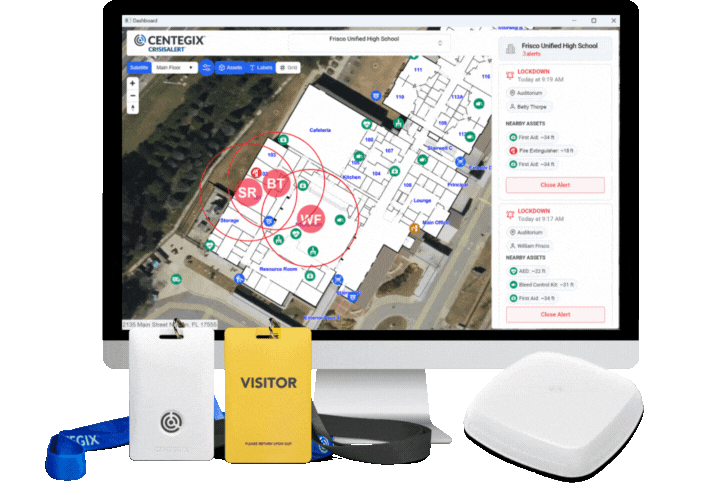Educators enter the teaching profession because they want to contribute to their students’ and communities’ success. Unfortunately, the teaching mission is no longer just about educating students, it’s about classroom safety and management more than ever before. Increases in behavior and safety incidents in schools create environments in which teachers don’t feel safe and secure.
Nationwide staff shortages contribute to this feeling of insecurity; when incidents arise, schools may lack sufficient personnel to support teachers. Furthermore, traditional methods of calling for help in these situations are often inconsistent. Intercoms, cell phones, and two-way radios are not always helpful or reliable ways to summon assistance from other members of staff.
A school safety plan must take all these factors into account and include features that keep teachers safe despite staff shortages and increases in safety incidents.
Why Teachers Need Help

Fewer resources and staffing shortages mean that many educators are required to play the roles of teacher, nurse, counselor, coach, and/or disciplinarian—often at the same time. These increased demands add to a teacher’s workload and stress level. These additional responsibilities also make teachers first responders to all manner of incidents that may, in previous years, have been handled primarily by staff, counselors, and nurses. For instance, teachers are often the first to respond to medical emergencies, including allergic reactions and mental health episodes. They also support students with special needs and intervene in student conflict, physical fights, and incidents during which weapons are used. The energy and skills required to respond to these various student needs are very great indeed.
Furthermore, incidents in several of these categories are increasing: student elopement among students who do not have special needs constitutes a larger share of behavior incidents than ever before. Some students for whom the 2021-22 school year was their first for in-person learning are not habituated to the routines and expectations of classroom life; in some cases, these students may escape, or attempt to escape, campus.
Threats of violence against teachers are also increasing. According to a 2022 survey from the American Psychological Association, one-third of teachers report that they experienced at least one incident of verbal harassment or a threat of violence from students during the 2020-2021 school year. In addition, at least 18% of school psychologists and social workers, 15% of administrators, and 22% of other staff reported at least one violent incident by a student. Parents increasingly perpetrate violent incidents at school: in one Florida district, 40% of administrators and 29% of teachers had been threatened with violence by a parent. In this environment, teachers’ safety is at real risk. Furthermore, the resulting sense of insecurity under which educators are required to work contributes to stress and burnout.
Existing Ways to Call for Help are Inconsistent
In an environment where teachers may feel unsafe, and in which they are called upon to perform duties for which they may not be fully trained, a school safety plan must ensure access to quick, guaranteed assistance.
Many existing systems for summoning help are inconsistent or ineffective. Some schools are equipped with wall-mounted buttons or landline telephones. But when an incident that requires immediate response occurs, these may not be accessible; a staff member would need to leave the scene of an incident to call for help.
Two-way radios are in use at some schools and offer a method of quick and easy communication. The connection and sound quality may not always be ideal, and only one person can speak at a time. Lastly, a two-way radio requires that the staff person calling for help verbally announces their location and their need for assistance.
Some schools utilize a mobile app for teachers to use when incidents occur. These often have a low adoption rate, however, and many teachers are concerned about their privacy when installing an app onto their personal cell phones. More than anything, app use in emergencies is inconsistent and not reliable.
In addition, the possibility always exists that a call can go unanswered, in which case a teacher is left to handle contentious or dangerous situations alone. In some cases, a teacher might send a student to summon help. But the staff member alerted may be unavailable or unable to help, particularly in medical emergencies or when students with special needs are involved.
CrisisAlert Badge: A School Safety Plan that Works
A school safety plan designed for today’s reality includes a quick and discreet way to call for help, in any situation. In incidents from everyday incidents to medical emergencies to threats of violence, the CENTEGIX CrisisAlert Badge is a simple, secure, and reliable way for educators to call for help. Because the CrisisAlert Badge is worn on a lanyard around an educator’s neck or on a clip that attaches to their clothing, it is always accessible. It doesn’t call increased attention to individual students in the event of a conflict, so the risk of a call for help escalating a situation is eliminated.
Crucially, when a teacher calls for help using a CrisisAlert badge, help always comes. The CENTEGIX school safety plan offers cellular backup, an override feature that, Much like an Amber Alert, guarantees that a teacher’s call for help is received via cellular service should the internet connection fail. Educators who use a CrisisAlert Badge can rely on support arriving quickly; they’re never left alone to handle sensitive situations on their own. This gives teachers a strong sense of security so that they can put their energy into doing what they love—educating students.
For example, one teacher used the CrisisAlert Badge to call for help in an incident of student elopement. Before their school adopted a safety plan that included the CrisisAlert Badge, this teacher would have used a cellphone to call the office for help. Instead, they were able to click the badge around their neck while remaining attentive to other students, and help came quickly. “The response was so fast and, thankfully, my student was safe. It makes me feel safer in my school,” said the teacher.
In medical emergencies, too, the CrisisAlert Badge facilitates quick and discreet assistance. One teacher cited an incident in which a student was having a seizure in class that was not evident to other students. The teacher said, “I was able to notify the appropriate school staff without alarming the rest of the class with my badge. When I pressed the alert we had medical staff and admin staff in the room swiftly.”
The CENTEGIX CrisisAlert Badge is a school safety plan that ensures quick, practical support for teachers. As a result, these teachers are granted a feeling of safety and security that allows them to concentrate on the work about which they are most passionate: teaching and caring for kids.
CENTEGIX is the leader in incident response solutions. Our CrisisAlert platform is the fastest and easiest way for staff to call for help in an emergency, from the everyday to the extreme. CENTEGIX creates safer spaces by innovating technology to empower and protect people, and leaders nationwide trust our safety solutions to provide peace of mind. To learn more about how CENTEGIX can help you support your teachers and staff, visit www.centegix.com.










